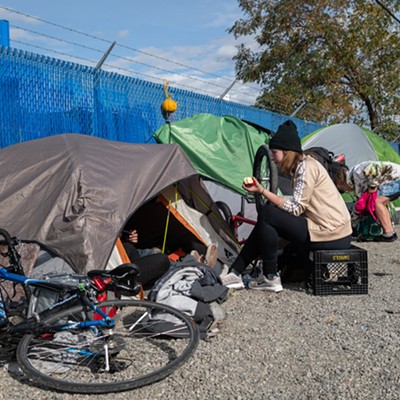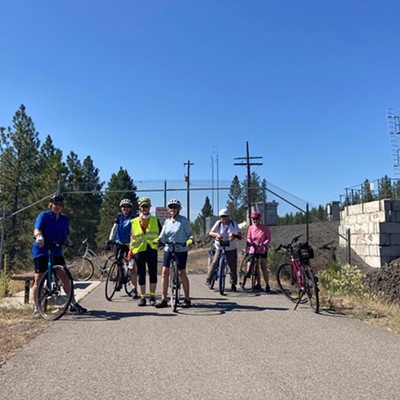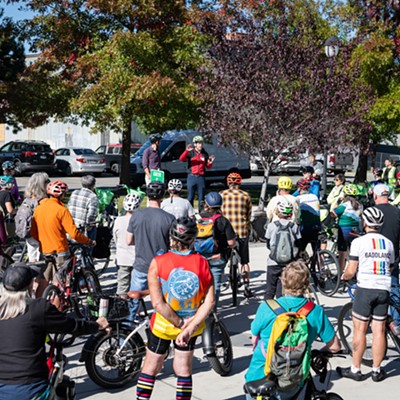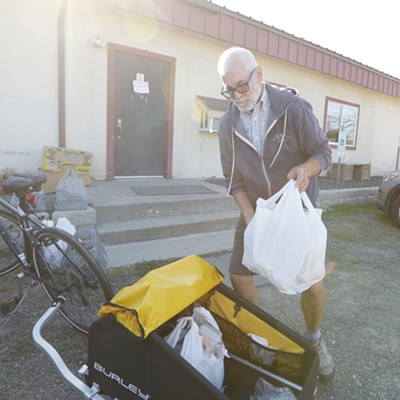Sixty-two cyclists showed up under threatening skies two Sundays ago to ride the two-and-a-half miles up Spokane's Southeast Boulevard to 29th Avenue for breakfast. The occasion? The brand new, almost never-been-ridden bike lane that runs all along the boulevard. In a city that flaunts its nearness to nature and perfection but lacks many bicycling amenities, it's reason to celebrate.
At a press conference at the bottom of the hill three days earlier, a small crowd of cyclists, dignitaries and press cameras gathered to commemorate the completion of the project, which repaved Southeast Boulevard from Perry Street to Third Avenue, with bike lanes stretching to the interstate. In full campaign mode Mayor Dennis Hession, standing at a portable lectern, his back to Sherman Street, said it was an "exciting opportunity" to showcase the work the city is doing and noted that while "it's always challenging to add in bike facilities ... it's consistent with the Comprehensive Plan" and makes it a "unique project." What the mayor didn't say was that the city never intended to put in the bike lanes until activists rallied for them. And even then, it may never have happened if it wasn't election season.
The repaving of Southeast Boulevard was part of the $117 million street bond championed by former Mayor Jim West and approved by voters in 2004. The Citizens Streets Advisory Commission (CSAC), the committee that helped usher in the program and now oversees it, promised a weary electorate at the time that the money would be spent exclusively to fix streets.
The issue exploded last year, though, as CSAC prepared to fix Bernard Street on the South Hill. Did the money promised for streets also include street amenities -- like crosswalks, pedestrian buffer strips and bike lanes -- or simply the reconstruction of the street surface? CSAC contended the latter, but many in the surrounding neighborhood -- including activist and current city council candidate Richard Rush -- believed the former.
"It was in complete contradiction to what's in the Comprehensive Plan," Rush says of CSAC's position, noting that the citizen-born plan is extremely detailed when it comes to what the city's streets should look like, with amenities for pedestrians and cyclists. The repaving would take Bernard Street off the city's to-do list for decades. If it wasn't going to implement the Comp Plan's intent now, when would it?
Thus, the paradox. The city's publicly vetted plan for the future expressed the need for crosswalks and bike lanes, while the city's publicly approved street-repair bond specifically left them out.
Add to that, says Max Kuney, an engineer and a member of CSAC, that the Comp Plan specifically states that the Comp Plan's standards "are not intended to apply to the resurfacing, restoration or rehabilitation of existing arterials."
"The Comp Plan specifically says that street rehab projects are exempted from the additional things the Comp Plan likes to see. That's not something we made up," Kuney says. "What we do is we're repaving the streets exactly the way they were. If there were bike lanes there before, there will be bike lanes after. We're not going to add new bike lanes."
Others, though, point to the same Comp Plan passage, which states that its standards "apply to the reconstruction of arterials as outlined in the current capital improvement program" and argue that projects like Bernard fall under that category.
"It seems pretty clear-cut from a legal standpoint that implementation is required," Rush notes.
Still, none of the Comp Plan's vague (and toothless) language was resolved before the repaving of Southeast Boulevard, and the project went to bid without bike lanes.
Bicycle Advisory Board chair Bob Lutz says that's when he went to the city for help. "I met with Mary Verner at the time," he says. "I was really looking for an advocate on the city council, and she seemed like a logical one." Verner, who was then beginning a run for mayor, facilitated discussions between the bicycle board and CSAC, which refused to pay for bike lanes but left the door open for them if funding could be found, Lutz says.
"Once the mayor announced there was a budget surplus, Verner again presented herself at one of our BAB meetings and asked for our input. Where did we potentially want her to prioritize? Where should she focus?" he says. "We said Southeast Boulevard." The council unanimously approved an emergency budget ordinance to pay the $50,000 tab for the bike lanes the next week.
Lutz says one of the bike board's strongest supporters in recent months has been councilman Brad Stark, who is running for re-election against Rush, a cycling activist. Rush sees political opportunism in that. Lutz refuses to speculate but notes that it's been Stark and Verner asking the bike board what they want to see in the coming year's budget, not the other way around.
In fact, Stark is now pushing the Bicycle Advisory Board to accelerate its plans so they'll be ready in time for that budget. In particular, the councilman is pushing the board to quickly develop a report on the feasibility of implementing a number of "bicycle boulevards" throughout Spokane -- a plan the board has been considering but didn't realize it had the political capital to so quickly initiate.
Bicycle boulevards, especially popular in Berkeley, Calif., are shared roadways that have been optimized for bike traffic. Using traffic calming techniques like roundabouts, speed bumps, textured roads and special signage, the boulevards slow traffic down, giving cyclists a comfortable route. Local motor traffic can still use the boulevards, but the speed bumps and traffic circles make them the last streets a motorist looking for a quick shortcut would want to use.
At a meeting Friday, Stark asked members of the board (along with representatives from the city's planning and engineering departments) to have a report ready for him to present at Nov. 16's budget-focused city council meeting. That will involve three separate groups looking at potential routes for pilot projects (Wall Street has been considered for the north side; on the south side, board members are looking around Rockwood Boulevard), mapping out what the boulevards will actually look like and producing cost estimates.
Lutz, who has expressed concerns before that he doesn't want to endanger the project by rushing it, says he believes the group can deliver by the 16th. He notes that the city has already done some due diligence on the project and stresses that the board will first try to implement temporary solutions (say, using gravel barrels -- rather than cement ones -- to divert traffic) and gather neighborhood input on how the project is working before recommending that anything be made permanent. "For a pilot project, it only makes sense to do it right," he says.
Lutz says some have wondered if the project would go through should Stark fail to get re-elected but adds that the unprecedented level of city support backing it indicates it likely will. He notes that "[chief operating officer] John Pilcher has really glommed onto the idea in a big way" and that both the planning and engineering departments support it (the latter because it gets cyclists off of arterial streets).
Support for Spokane's bike community is coming from outside the city, too. The bike board recently received a $15,000 grant from the National Park Service to help develop a master bike plan for the city.
"A new one is called for in the Comp Plan," says Lutz. "We're going to be looking at routes, getting public input, looking at where to put new bike facilities, and -- importantly -- needing to create ordinances. We really need to have some teeth behind what we're recommending."
Through careful negotiation, the Southeast Boulevard reconstruction project was a success for most involved. Drivers got a smooth road. Bikers got lanes. Mayor Hession got to cut the ribbon. Verner and Stark got to say they helped make it happen. Even Kuney seems happy with it.
"It's not that we don't like bike lanes," says the CSAC engineer. "We in fact like bike lanes, but that's just not what the money's there to pay for." He worries that with inflation, the commission won't even have enough money to finish the projects they promised. "If you can find alternate funding [for bikes], that's great."
Still, there's no telling what will happen next time. (Will the city fork over another emergency check?) And there will be a next time. A map put together by city staffers working with the Bicycle Advisory Board overlays streets targeted by the bond money and streets identified by the Comp Plan as future bike corridors. There's a lot of overlap.
John Speare, a bike board member and author of the popular Cycling Spokane blog, stresses the need for implementational teeth, saying the city needs to close the loophole that makes existing streets exempt from Comp Plan standards. "We need to bake funding of bike/ped stuff into the budget," he says.
Lutz underscores the need for outside funding of repaving projects. "It's not coming from the bond money," he say. "Whether that continues is up for debate [but] with the people on [CSAC] now, there's no room for debate."




















